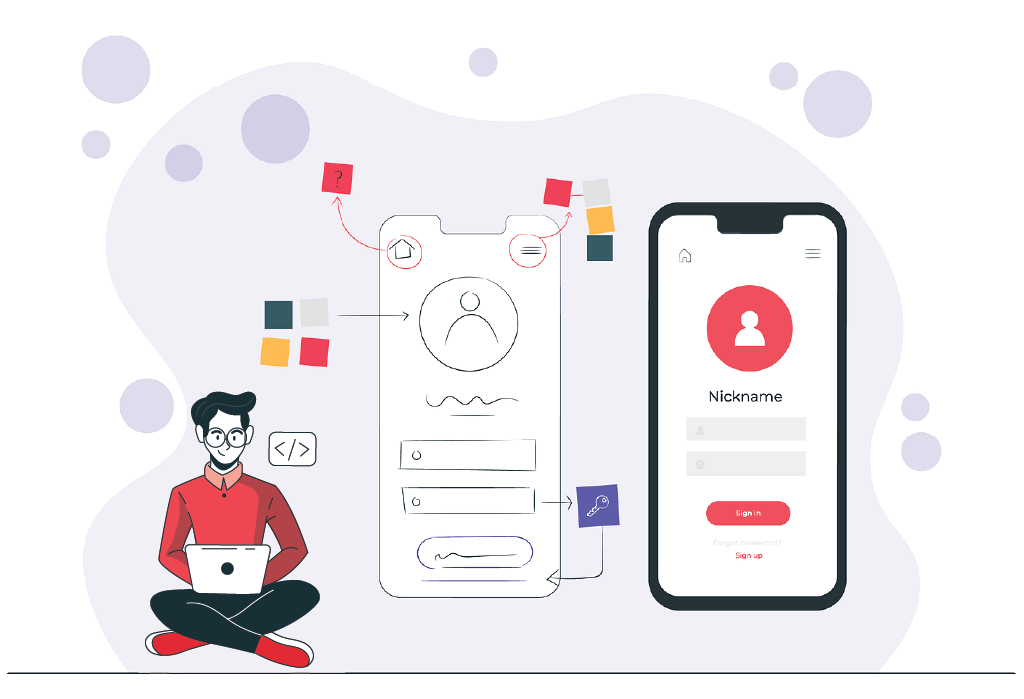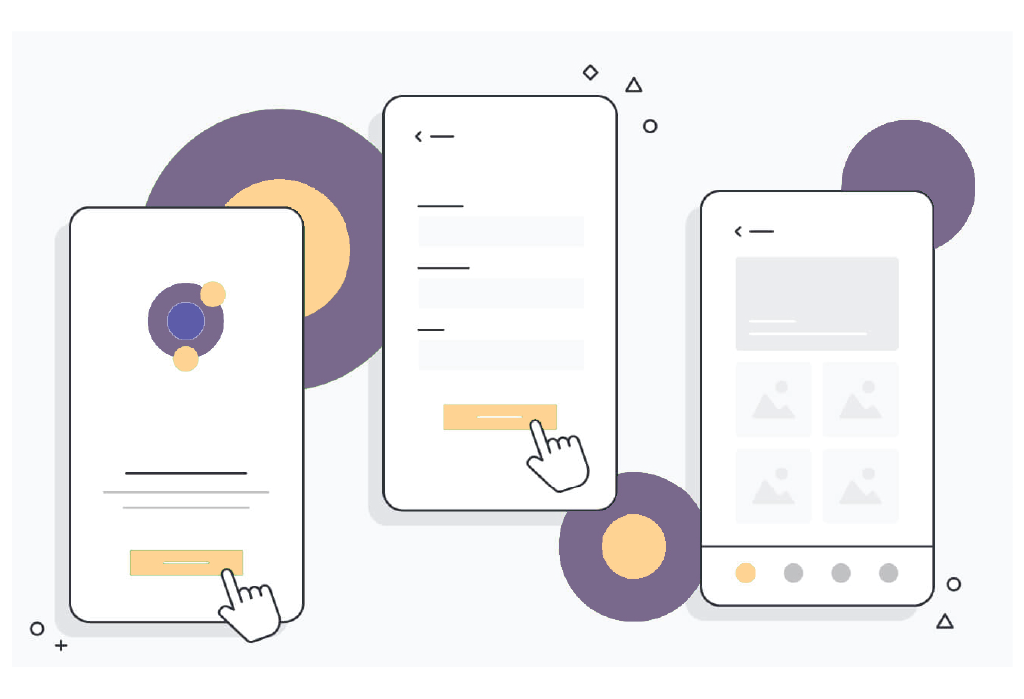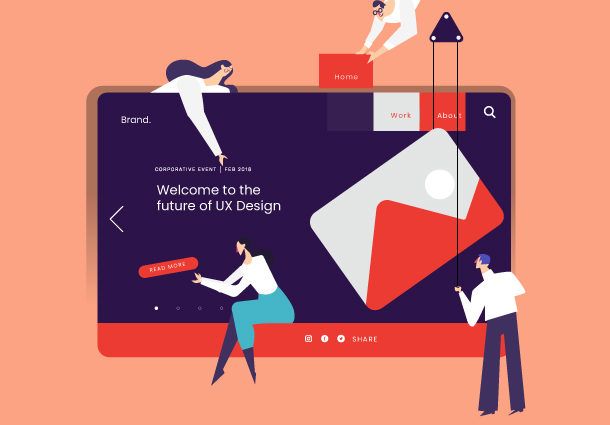Journeying towards User-Centric Experiences through Information Architecture
In a world of computers and smartphones that is constantly changing, user engagement is the best indicator of successful design. A website or application’s user interface and navigation are frequently what determine whether it’s successful or unsuccessful. To build environments that captivate, educate, and support people, we delve deeply into the intricate field of information architecture in design. Imagine a library without a catalog, a city without signposts, or a puzzle without its guiding picture. Just as these analogies describe the importance of structure and direction, Information Architecture (IA) plays a pivotal role in the digital universe. It is the compass guiding users through the intricate maze of information, seamlessly connecting them to the content they seek.
Information Architecture goes beyond the boundaries of website structure and encompasses applications, databases, and content management systems. It serves as a connection between user requirements and business objectives, aligning them to enhance user engagement. The core of any triumphant digital experience lies in the intricate coordination of content organization, user expectations, and adherence to usability best practices. Upcoming research on Maximizing User Engagement through Information Architecture in Design will introduce principles, strategies, and tools that enable designers to create intuitive, user-centered digital landscapes. Come along on this adventure to discover how information architecture might alter our perceptions of and interactions with the digital environment.
Architecting User-Centric Excellence: Unveiling the Role and Impact of Data Architecture in UI Design
Given how quickly paced and data-centric the area of User Interface (UI) design is, the importance of Data Architecture in this context cannot be overstated. Organizing, storing, and managing data and making sure that the pertinent information is delivered in the correct format at the right time, creates the groundwork for developing outstanding user experiences. Data architecture orchestrates the symphony of user interactions by serving as the invisible structure that supports each button click, hover, or press. Data Architecture in UI Design, at its core is all about creating a seamless and intuitive experience. The user interface is not just a visual facade; it is a gateway to a treasure trove of data. An effective data architecture ensures that this data is not only accessible but also structured sensibly. It considers how users interact with information and tailors the presentation to match their needs and expectations.
One of the primary impacts of sound Data Architecture is the optimization of performance. When data is efficiently organized and retrieved, UI elements respond swiftly, delivering a responsive and enjoyable user experience. Additionally, data architecture ensures data integrity and security, safeguarding sensitive information from breaches and unauthorized access.  Data-driven decision-making is another area where Data Architecture plays a significant role in UI design. By structuring data effectively, designers can empower users with insights, reports, and analytics, making informed choices a breeze. Furthermore, data architecture establishes consistency across UI elements, leading to a uniform and coherent design. It guarantees that data displayed across various screens and components is aligned, reducing confusion and enhancing the overall user experience.
Data-driven decision-making is another area where Data Architecture plays a significant role in UI design. By structuring data effectively, designers can empower users with insights, reports, and analytics, making informed choices a breeze. Furthermore, data architecture establishes consistency across UI elements, leading to a uniform and coherent design. It guarantees that data displayed across various screens and components is aligned, reducing confusion and enhancing the overall user experience.
In essence, Data Architecture is the unsung hero of UI design, operating in the background to elevate user experiences. It transforms data into a valuable, accessible resource, ensuring that UI designs are not just visually appealing but also functional, efficient, and user-centric. In the evolving landscape of digital design, understanding the profound impact of Data Architecture is essential for crafting interfaces that resonate with users, driving engagement, and ultimately achieving design excellence.
Unlocking User Engagement: A Guide to Best Practices
User engagement is the lifeblood of any digital platform or product, and unlocking its full potential requires a strategic approach. To excel in this endeavor, it’s crucial to follow best practices that resonate with your audience and drive meaningful interactions. Here, we unveil a comprehensive guide to maximize user engagement, touching on key principles and strategies. Understanding your users is the cornerstone of effective engagement. Conduct in-depth research to profile your target audience, learning about their preferences, behaviors, and pain points. This insight will guide the design and content decisions that resonate with them. A seamless and intuitive user interface is non-negotiable. Prioritize responsive design, optimize loading times, and ensure easy navigation. A user-friendly experience keeps visitors engaged and encourages return visits.
Compelling, relevant, and well-structured content is a magnet for users. Create informative, shareable, and visually appealing content that addresses user needs, and maintains a consistent posting schedule to keep your audience engaged. Tailoring the user experience through personalization is a proven way to boost engagement.  Utilize data and analytics to deliver personalized recommendations, content, and communication, demonstrating that you understand and value each user’s preferences. Given the prevalence of mobile device usage, ensuring your platform is mobile-responsive is paramount. Users should have a consistent, enjoyable experience whether they access your site on a desktop or smartphone. Integrate social media features to facilitate sharing, commenting, and social engagement. This extends your reach and fosters a sense of community around your platform.
Utilize data and analytics to deliver personalized recommendations, content, and communication, demonstrating that you understand and value each user’s preferences. Given the prevalence of mobile device usage, ensuring your platform is mobile-responsive is paramount. Users should have a consistent, enjoyable experience whether they access your site on a desktop or smartphone. Integrate social media features to facilitate sharing, commenting, and social engagement. This extends your reach and fosters a sense of community around your platform.
Gamify your platform by adding elements like rewards, badges, and challenges. These tactics tap into users’ competitive and achievement-driven instincts, creating an engaging and interactive environment. Continuously refine your approach through A/B testing. Experiment with different layouts, content types, and engagement mechanisms to identify what works best for your audience. Create channels for user feedback and actively listen to your audience. Implement their suggestions and communicate changes, showing that you value their input. Consistency is key to building trust and loyalty. Maintain a consistent brand identity, messaging, and user experience across all touchpoints. By adhering to these best practices, you can craft a user-centric strategy that fosters deeper, more meaningful connections with your audience, resulting in maximized user engagement and long-term success.
Key Considerations for Choosing a UI-UX Design Firm
Selecting the right UI-UX design company is a critical decision that can significantly impact the success of your digital product. To make an informed choice, consider the following criteria:
Begin by reviewing the company’s portfolio. Assess their past projects to gauge their design style, creativity, and versatility. Look for experience in your industry or similar projects, as it can provide valuable insights into their ability to address specific challenges and audience preferences. Evaluate the skill set of the design team. Ensure that they possess a comprehensive understanding of user-centered design principles, information architecture, and usability. Proficiency in relevant design tools and technologies, such as Adobe XD, Sketch, Figma, and prototyping tools, is also crucial. Reach out to past and current clients for references. Inquire about their experiences with the design company, including communication, adherence to deadlines, and the overall quality of their work. Satisfied clients are a strong indicator of a design company’s reliability. A reputable UI-UX design company conducts thorough user research to understand your target audience. They should employ user testing methodologies to validate design decisions and make data-driven improvements throughout the project.
Assess the design company’s process. They should have a structured approach, from initial concept and wireframing to prototyping and final design. This process should be transparent, adaptable, and collaborative, allowing your input and feedback at various stages.  Look for a design team that brings fresh and innovative ideas to the table. Creativity in design is what sets exceptional user experiences apart. They should be able to think beyond the conventional and create solutions that stand out. Effective communication and collaboration are essential for a successful partnership. Ensure that the company maintains open channels of communication, promptly addresses your queries, and fosters a collaborative atmosphere where your input is valued. Meeting deadlines is crucial in the fast-paced world of digital design. Assess the company’s project management capabilities and their commitment to delivering on time and within budget. In an age of diversity and inclusion, the ability to design accessible and user-friendly interfaces is vital. Ensure that the design company prioritizes accessibility standards and understands the importance of catering to diverse user needs. While cost is a factor, it should not be the sole determining criterion. Assess the overall value that a design company offers. Consider the long-term benefits of a well-executed design in terms of user engagement, brand recognition, and return on investment. By carefully evaluating these criteria, you can choose a UI-UX design company that aligns with your project’s goals, ensuring a harmonious and productive partnership that leads to a successful and user-centric digital product.
Look for a design team that brings fresh and innovative ideas to the table. Creativity in design is what sets exceptional user experiences apart. They should be able to think beyond the conventional and create solutions that stand out. Effective communication and collaboration are essential for a successful partnership. Ensure that the company maintains open channels of communication, promptly addresses your queries, and fosters a collaborative atmosphere where your input is valued. Meeting deadlines is crucial in the fast-paced world of digital design. Assess the company’s project management capabilities and their commitment to delivering on time and within budget. In an age of diversity and inclusion, the ability to design accessible and user-friendly interfaces is vital. Ensure that the design company prioritizes accessibility standards and understands the importance of catering to diverse user needs. While cost is a factor, it should not be the sole determining criterion. Assess the overall value that a design company offers. Consider the long-term benefits of a well-executed design in terms of user engagement, brand recognition, and return on investment. By carefully evaluating these criteria, you can choose a UI-UX design company that aligns with your project’s goals, ensuring a harmonious and productive partnership that leads to a successful and user-centric digital product.
Elevating Digital Excellence: Uniting Data Architecture, User Engagement, and UI-UX Design
In this exploration of the pivotal elements of modern digital design, we’ve unearthed the profound role and impact of Data Architecture in UI Design. It’s the invisible backbone ensuring seamless user experiences, optimizing performance, and fostering data-driven decision-making. Coupled with Data Architecture, the discussion on Best Practices for Maximizing User Engagement elucidates the strategic steps necessary for captivating and retaining a digital audience. From personalization to responsive design and user-focused content, these practices transform user interactions into meaningful, lasting connections.
In the realm of UI-UX design, Pattem Digital emerges as the beacon of excellence offering top-notch Information Architecture Design services With a wealth of experience, a seasoned team, and a stellar portfolio, Pattem Digital understands the intricate dance of data and design. They’ve mastered the art of harmonizing Data Architecture, User Engagement, and UI Design, creating digital experiences that are not only aesthetically appealing but also functionally exceptional. By uniting these elements, Pattem Digital crafts digital solutions that resonate with users, maximize engagement and elevate the entire user experience. The choice is clear: when it comes to seamlessly blending the components of modern digital design, Pattem Digital stands as the foremost choice for transforming your vision into digital reality.


